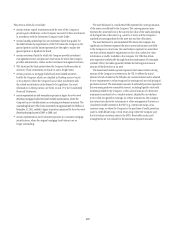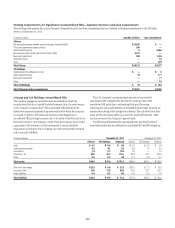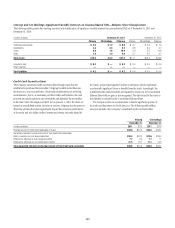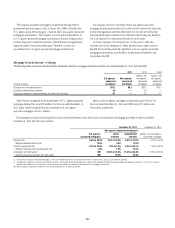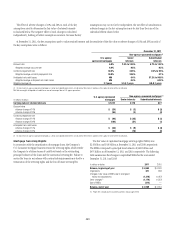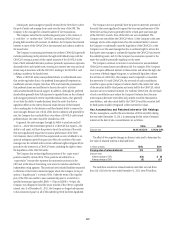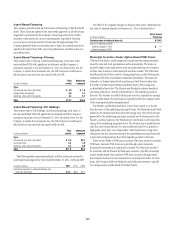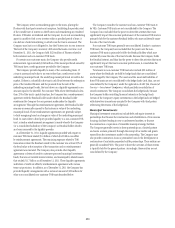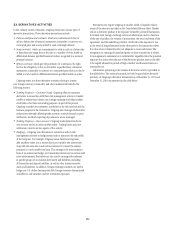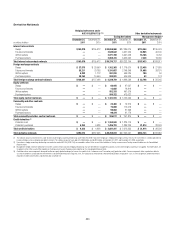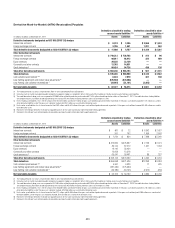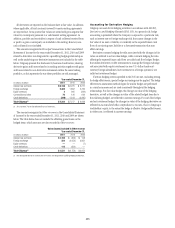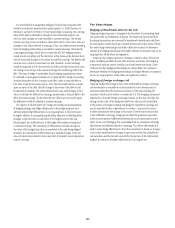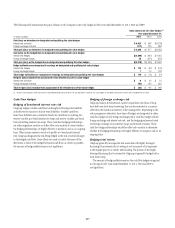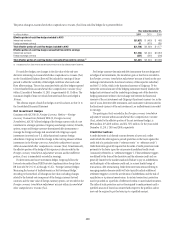Citibank 2011 Annual Report Download - page 250
Download and view the complete annual report
Please find page 250 of the 2011 Citibank annual report below. You can navigate through the pages in the report by either clicking on the pages listed below, or by using the keyword search tool below to find specific information within the annual report.
228
A third-party asset manager is typically retained by the CDO/CLO to select
the pool of assets and manage those assets over the term of the SPE. The
Company is the manager for a limited number of CLO transactions.
The Company earns fees for warehousing assets prior to the creation of
a “cash flow” or “market value” CDO/CLO, structuring CDOs/CLOs and
placing debt securities with investors. In addition, the Company has retained
interests in many of the CDOs/CLOs it has structured and makes a market in
the issued notes.
The Company’s continuing involvement in synthetic CDOs/CLOs generally
includes purchasing credit protection through credit default swaps with the
CDO/CLO, owning a portion of the capital structure of the CDO/CLO in the
form of both unfunded derivative positions (primarily super-senior exposures
discussed below) and funded notes, entering into interest-rate swap and total-
return swap transactions with the CDO/CLO, lending to the CDO/CLO, and
making a market in the funded notes.
Where a CDO/CLO entity issues preferred shares (or subordinated notes
that are the equivalent form), the preferred shares generally represent an
insufficient amount of equity (less than 10%) and create the presumption
that preferred shares are insufficient to finance the entity’s activities
without subordinated financial support. In addition, although the preferred
shareholders generally have full exposure to expected losses on the collateral
and uncapped potential to receive expected residual returns, they generally
do not have the ability to make decisions about the entity that have a
significant effect on the entity’s financial results because of their limited
role in making day-to-day decisions and their limited ability to remove the
asset manager. Because one or both of the above conditions will generally be
met, the Company has concluded that, even where a CDO/CLO entity issued
preferred shares, the entity should be classified as a VIE.
In general, the asset manager, through its ability to purchase and sell
assets or—where the reinvestment period of a CDO/CLO has expired—the
ability to sell assets, will have the power to direct the activities of the entity
that most significantly impact the economic performance of the CDO/
CLO. However, where a CDO/CLO has experienced an event of default or an
optional redemption period has gone into effect, the activities of the asset
manager may be curtailed and/or certain additional rights will generally be
provided to the investors in a CDO/CLO entity, including the right to direct
the liquidation of the CDO/CLO entity.
The Company has retained significant portions of the “super-senior”
positions issued by certain CDOs. These positions are referred to as
“super-senior” because they represent the most senior positions in the
CDO and, at the time of structuring, were senior to tranches rated AAA by
independent rating agencies. The positions have included facilities structured
in the form of short-term commercial paper, where the Company wrote put
options (“liquidity puts”) to certain CDOs. Under the terms of the liquidity
puts, if the CDO was unable to issue commercial paper at a rate below a
specified maximum (generally LIBOR + 35 bps to LIBOR + 40 bps), the
Company was obligated to fund the senior tranche of the CDO at a specified
interest rate. As of December 31, 2011, the Company no longer had exposure
to this commercial paper as all of the underlying CDOs had been liquidated.
The Company does not generally have the power to direct the activities of
the entity that most significantly impacts the economic performance of the
CDOs/CLOs as this power is generally held by a third-party asset manager
of the CDO/CLO. As such, those CDOs/CLOs are not consolidated. The
Company may consolidate the CDO/CLO when: (i) the Company is the asset
manager and no other single investor has the unilateral ability to remove
the Company or unilaterally cause the liquidation of the CDO/CLO, or the
Company is not the asset manager but has a unilateral right to remove the
third-party asset manager or unilaterally liquidate the CDO/CLO and receive
the underlying assets, and (ii) the Company has economic exposure to the
entity that could be potentially significant to the entity.
The Company continues to monitor its involvement in unconsolidated
CDOs/CLOs to assess future consolidation risk. For example, if the Company
were to acquire additional interests in these entities and obtain the right, due
to an event of default trigger being met, to unilaterally liquidate or direct
the activities of a CDO/CLO, the Company may be required to consolidate
the asset entity. For cash CDOs/CLOs, the net result of such consolidation
would be to gross up the Company’s balance sheet by the current fair value
of the securities held by third parties and assets held by the CDO/CLO, which
amounts are not considered material. For synthetic CDOs/CLOs, the net result
of such consolidation may reduce the Company’s balance sheet, because
intercompany derivative receivables and payables would be eliminated in
consolidation, and other assets held by the CDO/CLO and the securities held
by third parties would be recognized at their current fair values.
Key Assumptions and Retained Interests—Citi Holdings
The key assumptions, used for the securitization of CDOs and CLOs during
the year ended December 31, 2011, in measuring the fair value of retained
interests at the date of sale or securitization are as follows:
CDOs CLOs
$ISCOUNTæRATE 42.0% to 55.3% 4.1% to 5.0%
The effect of two negative changes in discount rates used to determine the
fair value of retained interests is disclosed below:
In millions of dollars CDOs CLOs
Carrying value of retained interests $14 $ 149
$ISCOUNTæRATES
!DVERSEæCHANGEæOFæ $ (3) $ (5)
!DVERSEæCHANGEæOFæ (5) (11)
The cash flows received on retained interests and other net cash flows
from Citi’s CLOs for the year ended December 31, 2011 were $93 million.


